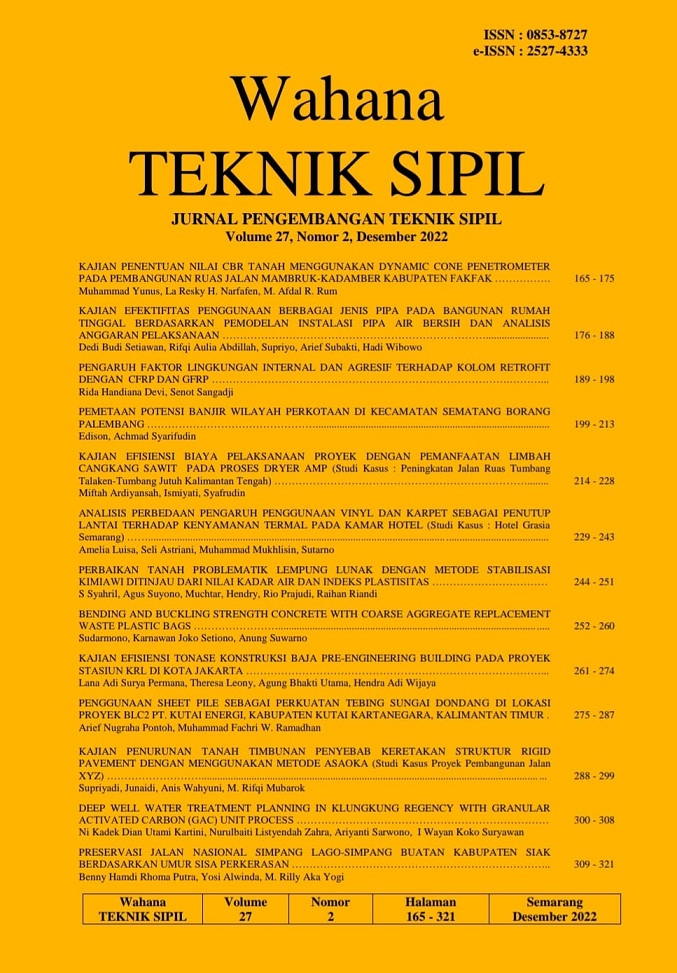KAJIAN EFEKTIFITAS PENGGUNAAN BERBAGAI JENIS PIPA PADA BANGUNAN RUMAH TINGGAL BERDASARKAN PEMODELAN INSTALASI PIPA AIR BERSIH DAN ANALISIS ANGGARAN PELAKSANAAN
DOI:
https://doi.org/10.32497/wahanats.v27i2.4140Abstract
The installation of clean water is a very important building component to support
the activities of residents in the building, because this component is a provider of
water needs for building occupants to carry out bathing, washing, cooking activities,
and so on. In planning a clean water installation system, four criteria must be met,
namely: Sufficient quantity, Hygienic, Optimal technical, and Economical. Research
has been carried out by modeling clean water installation to determine the type of
pipe that most effectively meets the clean water installation criteria to be applied to
residential buildings. The method used in this study is the modeling of a clean water
pipe installation with 3 types of pipes (Polyvinyl Chloride (PVC), Poly Propylene
Random (PPR), and Galvanis), measuring the flow rate and water pressure by
simulating all the open sanitation points and simulating one of the open sanitation
points in turn, then performing calculation of Implementation of Budget Plan for
pipe installation. The results showed that the flow rate and pressure readings on the
PVC pipe installation experienced an increase in the flow rate of 0.00624 m3 and
the pressure decreased by 3.015 psi, the PPR pipe installation experienced an
increase in the flow rate of 0.0104 m3 and the pressure decreased by 3.86 psi, while
the galvanized pipe installation experienced an increase in the flow rate of 0.029 m3
and the pressure decreased by 3,285 psi. The cost needed to make a PVC pipe
installation is Rp. 336,635, to make a PPR pipe installation of Rp. 514,583, and to
install a Galvanized pipe of Rp. 538,370. Based on the results of testing and analysis
of the implementation budget, it can be concluded that the most effective type of pipe
to be used in the installation of clean water pipes in residential homes is PVC pipe.
References
Artayana, K.C.B., dan Atmaja, G.I., 2010, Perencanaan Instalasi Air Bersih dan Air Kotor pada Bangunan Gedung dengan Menggunakan Sistem Pompa. Jurnal Ilmiah Teknik Mesin cakraM, 4, 1.
British Standard, 2006, Specifications for installations inside buildings conveying water for human consumption, European Committee for Standardization.
Peraturan Menteri Pekerjaan Umum dan Perumahan Rakyat.2022. Tentang pedoman penyusunan perkiraan biaya pekerjaan konstruksi bidang pekerjaan umum dan perumahan rakyat. Jaringan Dokumentasi dan Informasi Hukum. Jakarta.
Prahara, D., 2014, Perencanaan Sistem Plambing Air Bersih pada Bangunan Kondotel dengan Menggunakan Sistem Gravitasi dan Pompa. Jurnal Teknologi Lingkungan Basah, 2, 1.
Putra, D.A., Pratama, Y., dan Nurprabowo, A., 2015, Perencanaan Sistem Instalasi Plambing Air Bersih Gedung Park View Hotel. Jurnal Reka Lingkungan, 3, 97-107.
Putra, I.E., Sulaiman., Galsha, A.,2019, Analisa Rugi Aliran (Head Losses) pada Belokan Pipa PVC. Seminar Nasional Peranan Iptek Menuju Industri Masa Depan, 4, 34-39.
Rinaldy, A., Ismoyo, M.J., Dermawan, V., 2022, Studi Perencanaan Sistem Jaringan Pipa Distribusi Air Bersih dengan Software WaterCad di Perumahan Bulan Terang Utama Kota Malang. Jurnal Teknologi dan Rekayasa Sumber Daya Air, 2.1, 459-471.
Tanggoro, D., 1999, Utilitas Bangunan. Universitas Indonesia. Jakarta.
Standar Nasional Indonesia, 2000,tentang sistem plambing. Badan Standarisasi Nasional. Jakarta.
Standar Nasional Indonesia, 2005,tentang tata cara perencanaan sistem plambing. Badan Standarisasi Nasional. Jakarta.
Downloads
Published
Issue
Section
License
Authors who publish with this journal agree to the following terms:Authors retain copyright and grant the journal right of first publication with the work simultaneously licensed under a Creative Commons Attribution License that allows others to share the work with an acknowledgement of the work's authorship and initial publication in this journal.
Authors are able to enter into separate, additional contractual arrangements for the non-exclusive distribution of the journal's published version of the work (e.g., post it to an institutional repository or publish it in a book), with an acknowledgement of its initial publication in this journal.
Authors are permitted and encouraged to post their work online (e.g., in institutional repositories or on their website) prior to and during the submission process, as it can lead to productive exchanges, as well as earlier and greater citation of published work (See The Effect of Open Access).






